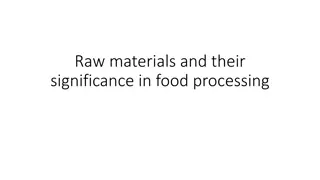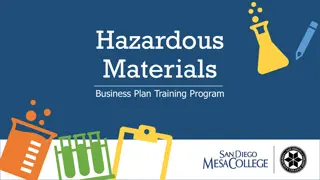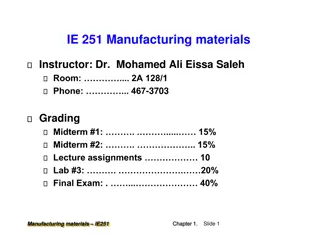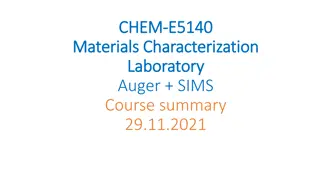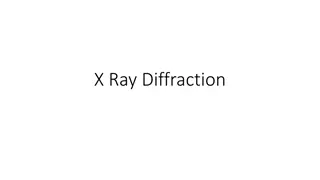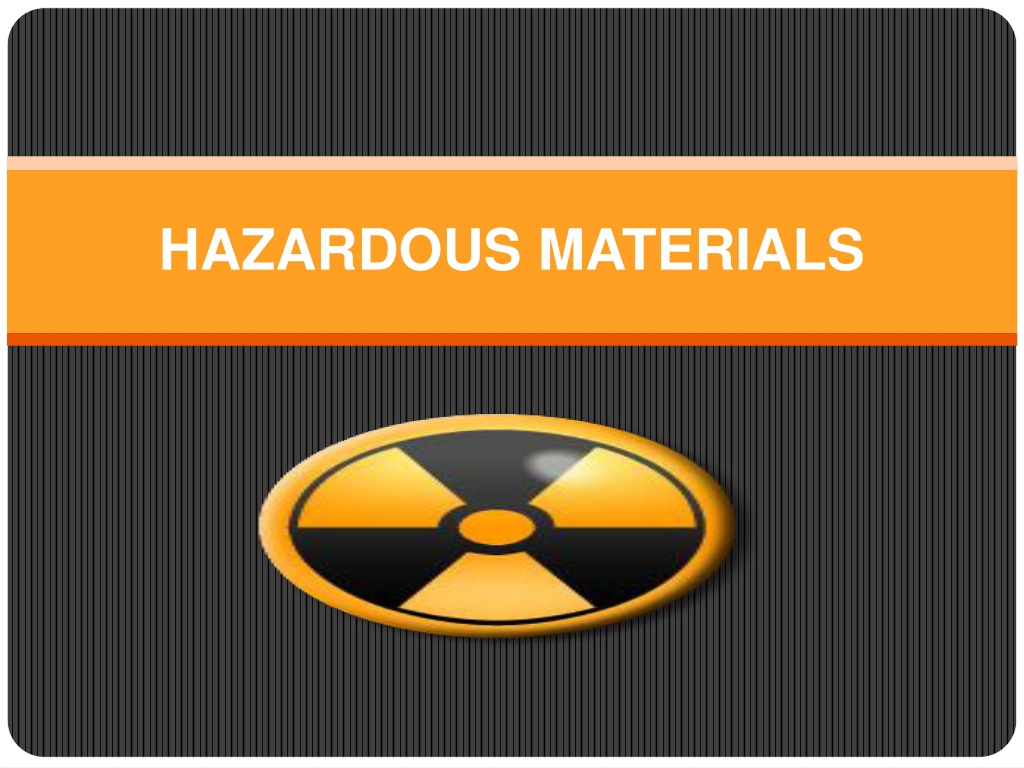
Understanding Hazardous Materials and Waste Management
Learn about hazardous materials, wastes, and the importance of proper handling and disposal. Explore hazard classification, labeling requirements, and the Globally Harmonized System for chemical safety. Discover different types of hazardous materials like infectious substances and radioactive materials that require special precautions.
Download Presentation

Please find below an Image/Link to download the presentation.
The content on the website is provided AS IS for your information and personal use only. It may not be sold, licensed, or shared on other websites without obtaining consent from the author. If you encounter any issues during the download, it is possible that the publisher has removed the file from their server.
You are allowed to download the files provided on this website for personal or commercial use, subject to the condition that they are used lawfully. All files are the property of their respective owners.
The content on the website is provided AS IS for your information and personal use only. It may not be sold, licensed, or shared on other websites without obtaining consent from the author.
E N D
Presentation Transcript
HAZARDOUS MATERIALS AND WASTES Hazardous materials are any materials in use that are considered to represent a threat to human life or health, or to the environment. Hazardous wastes are materials no longer in use that represents a threat to human life or health, and to the environment.
HAZARDOUS WASTES Knowledge of the proper procedures in the special handling, use, storage, and disposal of hazardous materials and wastes
RIGHT TO KNOW - GHS Globally Harmonized System of Classification & Labeling of Chemicals OSHA s Hazard Communication Standard gives employees working around hazardous chemicals the right to know of possible dangers and how to protect themselves. OSHA has chosen to incorporate the Globally Harmonized System of Classification and Labeling of Chemicals (GHS) into the HCS to: Account for changes in workforce Adapt to globalization Increase worker safety
HAZARD CLASSIFICATION Understanding Classification is the starting point for hazard communication. It involves you as an associate identifying the hazard(s) of a chemical or mixture by the assigned category of hazard by reading the labeling or finding it on the SDS sheets. Hazard Classification includes you performing steps: 1. Identifying data related to the hazards of a chemical and reviewing it to ascertain hazards 2. Determining that the chemical is hazardous (based on physical, health or other hazards) 3. Identifying the hazard class(es) for the chemical 4. Identifying the hazard category for each hazard class All can be found on the label or SDSs Sheets
LABELING Labels are intended to provide an immediate visual reminder of chemical hazards. All labels will be required to have: o Product identifier o Supplier identifier o Chemical identity o Hazard pictograms o Signal words o Hazard statements o Precautionary information
TYPES OF HAZARDOUS MATERIALS Infectious Substances Some infectious substances (such as some viruses) can be transmitted by blood and other body fluids, equipment, containers, paper goods, glassware, linens, and by people Radioactive Materials These require special handling techniques to prevent exposure to personnel and visitors
TYPES OF HAZARDOUS MATERIALS Flammable Liquids and Gases For example, chemicals, such as ether or alcohol, can burn or explode Toxic Chemicals A person may be exposed over a long period of time before effects are noticed
ROUTES OF ENTRY Inhalation- you breath it (most common) Ingestion- you eat it Absorption- soaks through skin Injection- puncture wound
REMEMBER Many hazardous materials are odorless, colorless, and tasteless You may be exposed before you know it Approach safely
SECTIONS FOUND ON SAFETY DATA SHEETS (SDS) Product and Company Identification Hazards Identification Composite/Information on Ingredients First Aid Measures Firefighting Measures Accidental Release Handling and Storage Exposure Control/Personal Protective Equipment Physical and Chemical Properties Stability and Reactivity
SAFETY DATA SHEETS CONT. Toxicological Information Ecological Information Disposal Considerations Transport Information Regulatory Information Other Information
KNOW THE POTENTIAL HAZARDS In each area of the facility where you work Observe signs Take precautions when entering an area identified as hazardous Know what s inside a container before you handle it
PERSONAL PROTECTIVE EQUIPMENT (PPE) Gloves Goggles Masks Gowns Aprons Footwear Good Hygiene
IN CASE OF UNKNOWN MATERIAL SPILL If capable, attempt to clean the spill yourself If unable, contact Housekeeping Protect the area to prevent other incidents from occurring Please take responsibility in helping keep MCHS clean and safe for all visitors and staff
IN CASE OF A CHEMICAL SPILL Rescue anyone in the area Alert PBX- Dial Ext 2000 Confine the spill/obtain appropriate PPE/clean area Extinguish or Evacuate MMH Activate Alarms-Dial 1100
BE SURE TO WASH YOUR HANDS Before entering or leaving the work area Before and after contact with a patient After handling items such as bedpans, dressings, etc. After removing gloves After using the toilet, blowing your nose or covering a sneeze Before eating, drinking or handling food or after smoking
PREVENT INJURIES FROM SHARPS Let falling objects fall Practice safe handling techniques Don t reach into containers Dispose of sharps carefully
IMPORTANT TIPS Take training seriously Avoid shortcuts Report unsafe conditions Know emergency procedures




